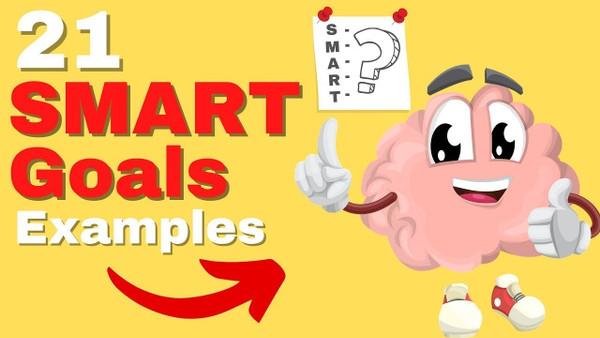21 SMART Goals Examples
Curated from: Develop Good Habits
Ideas, facts & insights covering these topics:
16 ideas
·9.43K reads
54
Explore the World's Best Ideas
Join today and uncover 100+ curated journeys from 50+ topics. Unlock access to our mobile app with extensive features.
Be SMART
SMART goals are a widely used and effective method for setting and achieving personal and professional goals. The acronym SMART stands for Specific, Measurable, Achievable, Relevant, and Time-bound, and refers to a set of criteria that a goal should meet in order to be considered effective. The SMART goal-setting method helps individuals and organizations set goals that are well-defined, achievable, and aligned with their values and priorities
136
1.42K reads
5 Components
The five components of SMART goals are:
- Specific: A specific goal outlines what you want to achieve and should be clearly defined.
- Measurable: A measurable goal should be quantifiable and have objective metrics for tracking progress.
- Achievable: An achievable goal should be realistic, given your resources and limitations.
- Relevant: A relevant goal should be meaningful and aligned with your values, priorities, and overall life goals.
- Time-bound: A time-bound goal should have a deadline or timeline, providing a sense of urgency and helping you prioritize your efforts.
154
1.08K reads
#1 Specific
The "Specific" component of SMART goals refers to the need for a goal to be well-defined and clearly outlined. A specific goal should answer questions such as "What do I want to accomplish?" and "How will I know when I have achieved it?" When a goal is specific, it helps to focus attention and avoid confusion or distractions.
A specific goal helps focus, track progress, measure success, and stay motivated. To set specific goals, it's important to be detailed and precise for a clear understanding of what you want to achieve and how.
126
736 reads
Key Elements to be SPECIFIC
For a goal to be considered specific, it should have several key elements:
- Clearly defined outcome: The goal should have a clear and defined outcome that is easy to understand and measure.
- Detailed: The goal should have enough detail to clearly articulate what is expected.
- Action-oriented: The goal should specify the actions required to achieve it so that you know what steps to take.
- Focused: The goal should be focused and not too broad, allowing you to concentrate your efforts and make consistent progress.
127
638 reads
128
973 reads
#2 Measurable
The "Measurable" component of SMART goals refers to the need for a goal to be quantifiable and have objective metrics for tracking progress. When a goal is measurable, it is easier to track progress, determine when you have achieved it, and stay motivated. Measuring progress helps you to see that you are making progress toward your goal, which can increase motivation and help you stay on track.
Setting measurable goals requires clarity and well-defined objectives and metrics for tracking progress. Regular tracking helps stay motivated and make necessary adjustments for goal achievement.
121
527 reads
Key Elements to be MEASURABLE
For a goal to be considered measurable, it should have several key elements:
- Objectives: The goal should have well-defined objectives and metrics for measuring progress.
- Quantifiable: The goal should be quantifiable, allowing you to track progress in a clear and tangible way.
- Data-driven: The goal should be based on data and information, allowing you to track progress and adjust your strategy as needed.
- Regular tracking: Regular tracking of progress is important in order to determine if you are on track to achieve the goal.
125
451 reads
#3 Achievable
The "Achievable" component of SMART goals refers to the need for a goal to be realistic and within reach, given your resources and limitations. When a goal is achievable, it is more likely to be accomplished, as you will have the necessary resources and support to make it happen.
Setting achievable goals requires considering resources, skills, and limitations, and ensuring the goal is realistic and within reach. This increases motivation and chances of success, and having a clear action plan helps ensure the goal is achievable.
120
390 reads
"Successful people set goals. They know where they're going, and they work towards a definite purpose."
BRIAN TRACY
119
528 reads
Key elements to become ACHIEVABLE
For a goal to be considered achievable, it should have several key elements:
- Realistic: The goal should be realistic and achievable within your current resources, skills, and limitations.
- Challenging: The goal should challenge you, but not be so difficult that it is unattainable.
- Resources: The goal should be achievable with the resources available to you, such as time, money, and support.
- Action plan: The goal should have a clear action plan, outlining the steps you need to take to achieve it.
123
385 reads
#4 Relevant
The "Relevant" component of SMART goals refers to the importance of a goal being relevant and aligned with your values, priorities, and overall life purpose. A relevant goal is one that has significance and meaning to you and is aligned with your long-term goals and aspirations.
Setting relevant goals involves considering personal values, priorities, and life purpose, and ensuring alignment with these factors. This increases motivation and chances of success by making the goal significant and fitting into the overall life direction.
119
367 reads
Key elements to become RELEVANT
For a goal to be considered relevant, it should have several key elements:
- Personal significance: The goal should be meaningful to you, and align with your values, priorities, and overall life purpose.
- Relevance to larger goals: The goal should be aligned with your larger goals and aspirations, and contribute to your overall life direction.
- Relevance to the current situation: The goal should be relevant to your current situation, and take into consideration your current circumstances and limitations.
122
365 reads
#5 Time-bound
The "Time-bound" component of SMART goals refers to the need for a goal to have a specific deadline or time frame. This helps to create a sense of urgency and focus and ensures that the goal is not left open-ended or indefinitely postponed.
Setting time-bound goals involve having a specific deadline for a sense of urgency and focus. A deadline also increases motivation and allows for flexibility in goal achievement.
120
340 reads
Key elements to become TIME-BOUND
For a goal to be considered time-bound, it should have several key elements:
- Specific deadline: The goal should have a specific and clearly defined deadline or time frame.
- Urgency: The deadline should create a sense of urgency and help to keep you focused and motivated as you work towards achieving your goal.
- Flexibility: The deadline should be flexible enough to allow for adjustments or changes, if necessary.
122
335 reads
Take-home message
The SMART goal framework is a useful tool for setting clear, achievable, and measurable goals. The acronym SMART stands for Specific, Measurable, Achievable, Relevant, and Time-bound. By following this framework, individuals can create goals that are well-defined, realistic, and aligned with their values and priorities, which increases the chances of success and motivation.
119
438 reads
IDEAS CURATED BY
A learner who loves to share wisdom on personal growth, happiness, and success on Deepstash. Topics include motivation, habits, goals, and mindset. Believes that everyone can achieve their dreams with the right attitude and action.
CURATOR'S NOTE
The SMART framework helps individuals set clear, achievable, and relevant goals, with a sense of urgency, increasing motivation, focus, and chances of success. It clarifies goals, tracks progress, stays motivated, sets achievable goals, makes goals relevant and important, and sets a deadline for urgency.
“
Suman Saha's ideas are part of this journey:
Learn more about habits with this collection
How to strengthen your willpower
How to overcome temptation and distractions
The role of motivation in willpower
Related collections
Similar ideas
4 ideas
5 ideas
Read & Learn
20x Faster
without
deepstash
with
deepstash
with
deepstash
Personalized microlearning
—
100+ Learning Journeys
—
Access to 200,000+ ideas
—
Access to the mobile app
—
Unlimited idea saving
—
—
Unlimited history
—
—
Unlimited listening to ideas
—
—
Downloading & offline access
—
—
Supercharge your mind with one idea per day
Enter your email and spend 1 minute every day to learn something new.
I agree to receive email updates




